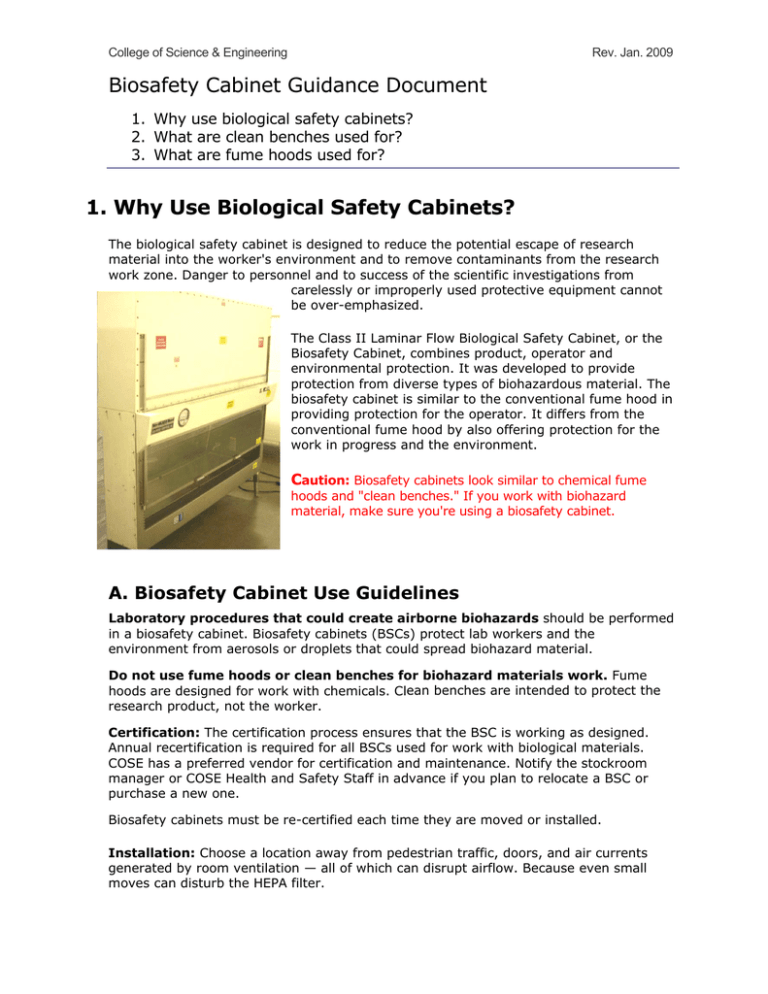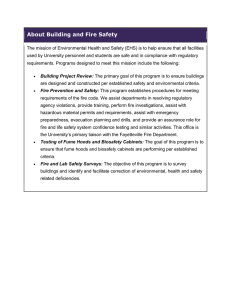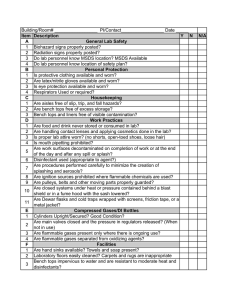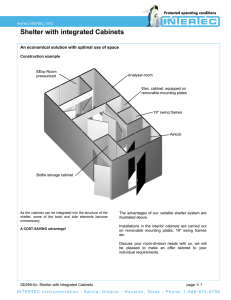Biosafety Cabinets
advertisement

College of Science & Engineering Rev. Jan. 2009 Biosafety Cabinet Guidance Document 1. Why use biological safety cabinets? 2. What are clean benches used for? 3. What are fume hoods used for? 1. Why Use Biological Safety Cabinets? The biological safety cabinet is designed to reduce the potential escape of research material into the worker's environment and to remove contaminants from the research work zone. Danger to personnel and to success of the scientific investigations from carelessly or improperly used protective equipment cannot be over-emphasized. The Class II Laminar Flow Biological Safety Cabinet, or the Biosafety Cabinet, combines product, operator and environmental protection. It was developed to provide protection from diverse types of biohazardous material. The biosafety cabinet is similar to the conventional fume hood in providing protection for the operator. It differs from the conventional fume hood by also offering protection for the work in progress and the environment. Caution: Biosafety cabinets look similar to chemical fume hoods and "clean benches." If you work with biohazard material, make sure you're using a biosafety cabinet. A. Biosafety Cabinet Use Guidelines Laboratory procedures that could create airborne biohazards should be performed in a biosafety cabinet. Biosafety cabinets (BSCs) protect lab workers and the environment from aerosols or droplets that could spread biohazard material. Do not use fume hoods or clean benches for biohazard materials work. Fume hoods are designed for work with chemicals. Clean benches are intended to protect the research product, not the worker. Certification: The certification process ensures that the BSC is working as designed. Annual recertification is required for all BSCs used for work with biological materials. COSE has a preferred vendor for certification and maintenance. Notify the stockroom manager or COSE Health and Safety Staff in advance if you plan to relocate a BSC or purchase a new one. Biosafety cabinets must be re-certified each time they are moved or installed. Installation: Choose a location away from pedestrian traffic, doors, and air currents generated by room ventilation — all of which can disrupt airflow. Because even small moves can disturb the HEPA filter. College of Science & Engineering Rev. Jan. 2009 B. Biosafety Cabinet Classification Class I biosafety cabinet A ventilated cabinet with an inward airflow and outlet HEPA filters. It was previously referred to as the CDC Hood and served a valuable function in its time by protecting personnel and the environment. Because it offers no product protection, it has been essentially obsolete for the past several decades. Class II (types A and B) Laminar Flow Biological Safety Cabinets that protect personnel, product and environment. They provide inward airflow to protect personnel, downflow HEPA filtered air to the work area to protect the product and exhaust HEPA filtered air to protect the environment from particulate and aerosol hazards. Class III cabinet Essentially a ventilated glovebox. This is a gas-tight chamber operated through sealed gloves which provide a complete barrier between the worker and hazardous material. The glovebox is maintained under negative pressure with HEPA filtered supply air and double HEPA filtered exhaust air. Purchase recommendation Several kinds of BSCs are available, divided into classes (I, II, and III) and types (A, B, C). The COSE recommends departments purchase Class II, Type A2 cabinets. Class II cabinets are designed to protect the research material as well as the worker and the environment. Both the supply air and the exhaust pass through a HEPA filter. There are 4 types of Class II cabinets. Class II Type A2 cabinets (formerly labeled Type A/ B3) have a number of design features that make them more useful in research laboratories than other Class II cabinets. Note: Class I and Class III cabinets are rarely used at SFSU. Class I cabinets do not protect the research material, and Class III cabinets (also called glove boxes) are completely contained cabinets that require workers to wear arm-length gloves attached to a front panel. More Information For more information about biosafety cabinets, check out the handbook, “Primary Containment for Biohazards: Selection, Installation and Use of Biological Safety Cabinets” from the Centers for Disease Control and Prevention. http://www.cdc.gov/od/ohs/biosfty/bsc/bsc.htm College of Science & Engineering Rev. Jan. 2009 2. What are clean benches used for? Two Main Types of Clean Benches Horizontal Laminar Flow “Clean Bench” Horizontal laminar flow clean air benches are not biological safety cabinets. They discharge HEPA-filtered air across the work surface and toward the user. Note the red area which indicates air flow toward the user. Clean benches are useful for dust-free assembly of sterile equipment or electronic devices. These should never be used to handle cell cultures, potentially infectious materials, or other biohazards. Vertical Laminar Flow “Clean Bench” Vertical laminar flow clean air benches are also not biological safety cabinets. They discharge HEPA-filtered air across the work surface and toward the user. Note the red area which indicates air flow toward the user. While these units often have a sash, the air is usually discharged into the room under the sash, resulting in the air moving toward the user. These should never be used to handle cell cultures, potentially infectious materials, or other biohazards. College of Science & Engineering Rev. Jan. 2009 3. What are chemical fume hoods used for? Conventional hood* This term is used to describe a constant air volume (CAV) hood, an older, traditionally less elaborate hood design used for general protection of the worker. Because the amount of exhausted air is constant, the face velocity of a CAV hood is inversely proportional to the sash height. That is, the lower the sash, the higher the face velocity. CAV hoods can be installed with or without a bypass provision which is an additional opening for air supply into the hood. Note here that room air is being pulled into the hood past the user and exhausted up the stack. A fume hood is intended to protect the user from chemical hazards and does not offer product protection from unfiltered air. *SFSU does not use variable air flow (VAV) fume hoods at this time.


